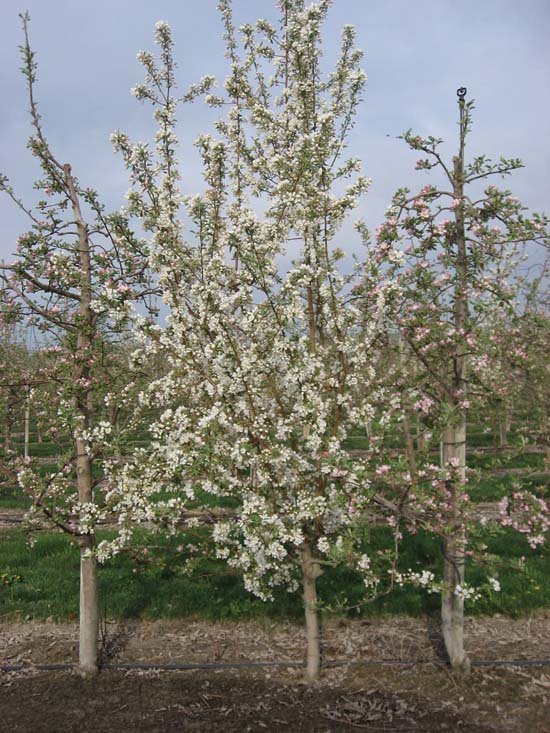
Scientists are recommending that the Washington apple industry look for alternatives to Manchurian crab, the predominant pollinizer, because it is a host of fungal pathogens of quarantine concern.
Trouble is, no studies have been done in the past 30 years to find other pollinizers that would fit the industry’s needs.
Ken Adams, president of Willow Drive Nursery in Ephrata, Washington, said that before the 1980s, when most of the apples grown in Washington were Red and Golden Delicious, growers used to plant four rows of Reds and two of Goldens so that the two varieties could pollinate each other.
Then, when growers began planting Granny Smith, Fuji, Gala, and other new varieties, they recognized the need to use pollinizers. This also enabled them to plant solid blocks of a single variety, making them more efficient to harvest.
Manchurian crab has been the most popular pollinizer because it blooms very early—in time to pollinate king bloom of Red Delicious. The timing is also good for most of the other major varieties grown in Washington, such as Fuji, Gala, and Granny Smith. Snowdrift, which blooms about seven days later, is also widely planted to pollinate later-blooming varieties. Adams said Willow Drive also sells smaller quantities of Indian Summer, Mont Blanc, and Evereste.
“Manchurian has been the workhorse. I’m not sure there’s one that could really replace it,” Adams said. “People don’t want to go back to the four rows of Reds and two rows of Golden Delicious. Solid blocks are so much more efficient, and you’re dealing with one crop. If they lose Manchurian, it’s going to be an issue.”
Specific needs
Ornamental nurseries sell a wide variety of crab apples, but the tree fruit industry has specific needs, said Tom Auvil, research horticulturist with the Washington Tree Fruit Research Commission. The pollinizer must bloom early enough to coincide with the earliest-blooming apple varieties, and it should have a tall, upright growth habit so it catches the bees as they fly over the tops of the trees. It should have white or pale pink flowers, which appear to be more attractive to bees than red blossoms.
It also needs to bloom annually and have good pollen viability and germination. Research at the Virginia Polytechnic Institute and State University, suggests that the pollen of Manchurian has a relatively slow pollen tube growth rate and so might not be the most efficient pollinizer (see “Optimizing pollination”).
Now, it appears that disease resistance is important, too.
“I think it’s time to get rid of Manchurian,” said Auvil, who has planted Manchurian in every block in his own orchard since 1990.
The ornamental wholesale nursery J. Frank Schmidt & Son, of Boring, Oregon, lists 39 crab apple varieties on its Web site, but little is known about their suitability as pollinizers in commercial orchards.
Dolgo, Jackii, and Pink Spires are the earliest bloomers.
Dolgo is thought to be a good candidate as a pollinizer as it has an upright growth habit, white blossoms, and good disease resistance. It is also one of the hardiest crabs.
Jackii produces profuse and long-lasting white blossoms and is hardy. It is resistant to scab, cedar-apple rust, mildew, and has some resistance to fireblight. The tree, however, is rounder (growing 20 feet tall and 20 feet wide) and not as tall as Dolgo.
Pink Spires would not fit the apple industry’s needs because of its bright pink flowers and reddish purple foliage.
Sugar Tyme blooms a little later but has potential because of its white flowers and upright growth habit.
Trial
Mike Willett, vice president for scientific affairs at the Northwest Horticultural Council, said good crab apple candidates need to be identified and then evaluated alongside the standard Manchurian crab. The most efficient way to do this would be in a research trial, rather than by growers individually. The question is, who would be able to organize such a trial?
Auvil said promising cultivars need to be screened for compatibility and performance with major fresh varieties that the industry grows. Characteristics that need to be evaluated include attractiveness to bees, tree structure, and disease tolerance.
Washington State University recently appointed horticulturist Dr. Desmond Layne to a new technology transfer position with the tree fruit industry, and Dr. Stefano Musacchi, a horticulturist from Italy, will join WSU in August. Auvil said it’s possible that one of the new faculty might propose to lead such a project.

Leave A Comment